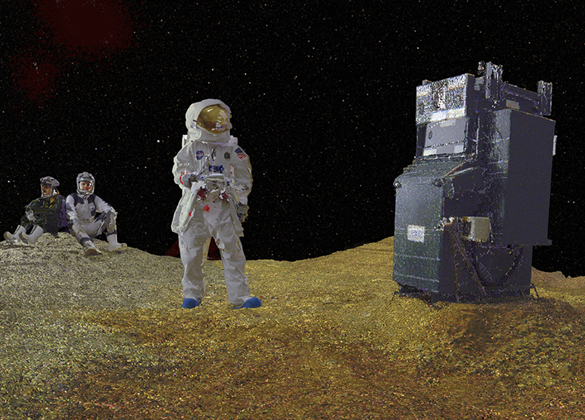Biography : Dr. Sarah Jane Pell's experimental practice transits from Sea to Summit to Space. A commercial diver and founder/director of the Aquabatics Research Team initiative 2002-12, she expanded creative research of human performance underwater by building extensive experience in remote isolated confined environment (ICE) maritime and diving operations. Sarah attempted to summit Mt. Everest (2015) and began civilian spaceflight training (2016) to investigate 'Performing Astronautics'. Dr. Pell collaborates with artistic, scientific and technical partners to understand and support the body and cultural expression of extreme performance. Awards include: Australia Council Fellow. Australia Council Arts Leader. Gifted Citizen - Hon. Mention. TED Fellow.
Spatial Performance Environment Creative Training Realities for Astronauts (SPECTRA)
Abstract : Imagine following the body's natural edge to the abyss of space to experience a new world perceived and expressed by the extra-terrestrial body. Here on Earth, I contend with the design of tactical laboratories promoting experimental arts practices to support performance research within remote isolated confined environment (ICE) operations. The idea is to create, simulate or inhabit space analogue sites and conditions. I find these scenarios challenge me to prioritise presence and absence in unique ways. Therein my perception, and behaviour alters, producing a new body, a new body of art, or new art. Collaborating with the Monash Immersive Visualisation Platform, we currently reconfigure tools testing spatial awareness during terrestrial analogue EVAs, post-processing large data transmission between global sites for affective visualisation in the CAVE2, Virtual Reality, Dome and Future Control Room. Artefacts include immersive media, mixed reality, new interactive systems for live art, translocation communication, and interdisciplinary human performance research. Outcomes are at once real and speculative; poetic and practical. They have differing technical cultural value and human factors benefit for crews and audiences. I now ponder how is the simulation within the simulacra, the science within the art, becoming an evolutionary survival tool itself?
 SPECTRA Spatial Performance Environment Creative Training Realities for Astronauts
SPECTRA Spatial Performance Environment Creative Training Realities for Astronauts
LiDAR Tableaux (2018)
Sarah Jane Pell in collaboration with David Barnes, MIVP and Lunares III Crew.
References
Pell, S.J. (2017) Performing Astronautics: following the body's natural edge to the Abyss of Space, Virtual Creativity, Vol. 7, Number 1, 1 June 2017, pp. 53-61(9) Intellect Publishing,
https://doi.org/10.1386/vcr.7.1.53_1
Pell, S.J. (2014), 'Aquabatics: a post-turbulent performance', Performance Research, Vol. 19, Issue 5. On Turbulence, Issue Editor: Prof. Paul Carter. Taylor & Francis, Routledge; 19(5):98-108.
https://doi.org/10.1080/13528165.2014.958365
Langston, S., Pell, S.J. (2015) What is in a name? Perceived identity, classification, philosophy, and implied duty of the "astronaut". Acta Astronautica (Impact Factor: 0.82) Elsevier. 05/2015; 115 (Oct-Nov): 185-194.
https://doi.org/10.1016/j.actaastro.2015.05.028
|









